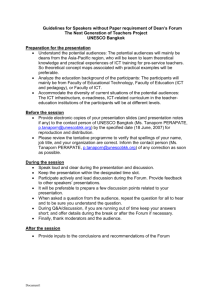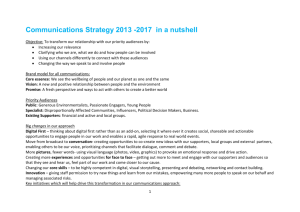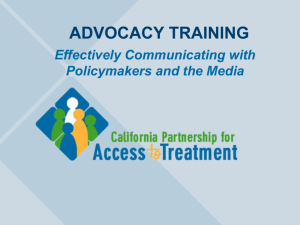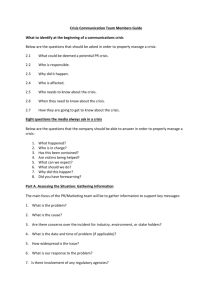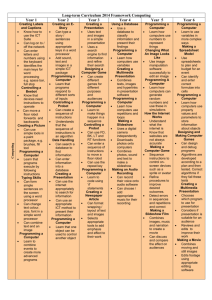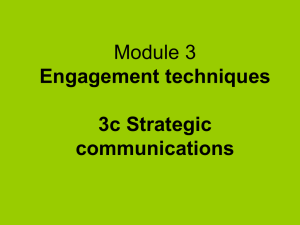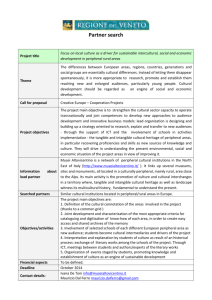Communications Strategy
advertisement
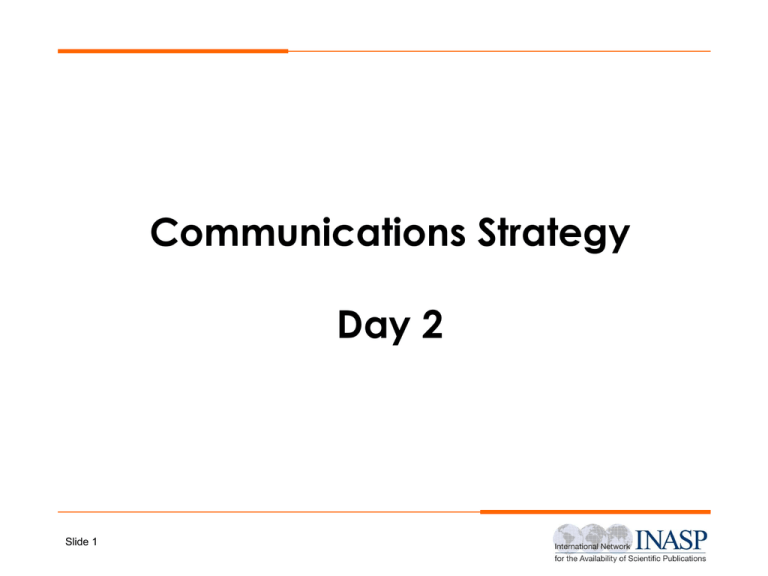
Communications Strategy Day 2 Slide 1 Communications Communications Strategy Strategy Planning Planning Slide 2 What is communications? • Is not an “anyone can do it if you have to” task. • An ongoing exchange of information (iterative process): relevant to audiences integral to the stages of the policy process conducted on a formal or informal basis Slide 3 What is a communications strategy? • A well thought out or carefully devised plan for broadcasting differences • A means of elaborating how we network, participate & interact with the world (e.g. to influence policy) • Is not an optional or fringe plan to be left to junior personnel or consultants (out-sourced) Slide 4 What if there is no communication strategy? • Difficult to measure activities not planned and organised • More reactive than proactive communication • Random activities not well thought out • Duplicating efforts • Mis/un-targeted messaging Slide 5 Internal and external communications Slide 6 Internal communications • • • • Keeps everyone in the know. Allows sharing of ideas. Synchronising messages. Singing the same song / speaking the same language. • Easy when it comes to handing over. Slide 7 External communications • Key messages for communication • Audiences/Stakeholders/Key people (segmentation) • Activities to carry out • Requires a communications strategy* • 5Ws & H – the Who, What, When, Why, Where & How. *Communications strategy can cover both internal and external communications. Slide 8 Communications strategy steps What are the essential elements / steps of a communications strategy? Slide 9 Organise a committee Steps in a communications strategy Analyse the situation Develop objectives Identify audiences Build partnerships Develop messages Select channels Develop action plan Evaluate Slide 10 Step 1: Establish a communications committee Committee members could include: – Staff from main implementing agency – Researchers – Members of relevant professional associations – Members of partner organizations – Members of the audience you are trying to reach (news media, religious leaders, etc) Slide 11 Step 2: Analyse the situation Analyse the situation carefully to understand the message & provide solid rationale for sharing. Slide 12 Step 3: Develop Objectives *What do we want our communications to achieve? Are our objectives SMART? • Policy communication objective – Raise awareness among policymakers about need for increased resources of ICT equipment. • Program objective – Increase the number of rural users of ICT or increased use of ICT by rural health workers… Slide 13 Develop Objectives and expected outcomes • Help journalists better understand the benefits ICT in poverty reduction, or its use amongst rural health workers . • Quantity and quality of news coverage about ICT use by rural health workers Slide 14 Step 4: Identify the audience • Primary – Who can directly affect policy on your issue? • Secondary – Who can influence those policymakers? – Who can stop being an obstacle? Slide 15 Who are possible audiences? • • • • • • Political leaders Governemnt officials Programme managers Private sector Educators Business/Civic leaders • • • • News media Donors Religious leaders Professional associations • Women’s groups * This is not an exhaustive list... Slide 16 Know your audiences • Who do they listen to? • What do they know about your topic? • Are they interested in your topic? • What are the best ways to reach them? (formats and channels) Slide 17 Step 5: Build partnerships • Enlist relevant organisations and individuals to join the advocacy movement to: – Augment the numbers – Strengthen the talent pool • Forming partnerships can be challenging! – Put into place participatory mechanisms – Identify roles and leadership structure Slide 18 Step 6: Developing messages • Start with the data and analysis • Present two to three points maximum • Tailor the message to fit the audience • Deliver through a credible source • Avoid technical jargon Slide 19 Step 7: Communication channels and activities • Face-to-face (Interpersonal): – Workshops, seminars – Conferences, meeting – Press briefings • Mass media – Press – Broadcast (Radio and TV) – New Media: Internet websites *Select formats that are most appropriate for your audiences. Slide 20 Step 8: Action plan Key Questions For whom When By what means By whom How often How many Slide 21 The devil is in the details Specify: – Advocacy activities - outline a detailed work plan – What resources are needed (human and financial) – Be alert to opportunities! Are there any upcoming events that will support your objective? Brainstorm on opportunities. Slide 22 Step 9: Evaluation • Performance – Were all the activities implemented, delivered and on time? • Impact – Did activities bring about the desired change? Slide 23 Effective communication strategies rely on: • Audience-centered approach • Ongoing communications activities • Disseminating information at the right time, for the right length of time Slide 24 If well designed • Communications activities and materials can create demand More requests for information More influence over policy Slide 25 Key aspects of a communications strategy: • • • • • • • Objectives Target individuals/organisations Activities Responsible people/person Timeline Budget Monitoring and evaluation Slide 26 Keep It Simple : the Good and the Bad “The last time we did an advocacy strategy and plan, it was 80 pages and took six months.” Communications specialist - CERPOD, Bamako, Mali Slide 27 Task: Identify 3 to 5 communication objectives and consider how you will achieve them Objective 1 Target group/organisation/person Interventions/activities Responsible person Timeframe Budget Monitoring and evaluation: Expect to see Like to see Love to see Summary: Communications Strategy • • • • • Why a communications strategy is important Internal and external communications Steps in a communications strategy Learn from others: good and bad strategies Be both proactive and reactive in communications Slide 29
